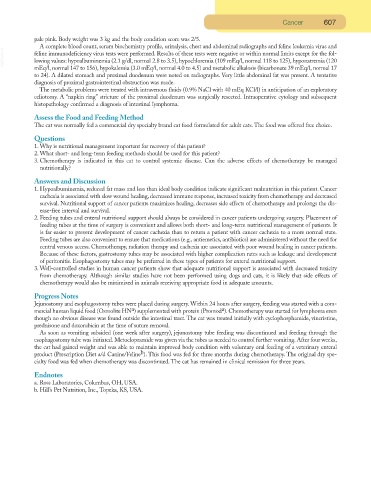Page 586 - Small Animal Clinical Nutrition 5th Edition
P. 586
Cancer 607
pale pink. Body weight was 3 kg and the body condition score was 2/5.
A complete blood count, serum biochemistry profile, urinalysis, chest and abdominal radiographs and feline leukemia virus and
VetBooks.ir feline immunodeficiency virus tests were performed. Results of these tests were negative or within normal limits except for the fol-
lowing values: hypoalbuminemia (2.1 g/dl, normal 2.8 to 3.5), hypochloremia (109 mEq/l, normal 118 to 125), hyponatremia (120
mEq/l, normal 147 to 156), hypokalemia (3.0 mEq/l, normal 4.0 to 4.5) and metabolic alkalosis (bicarbonate 39 mEq/l, normal 17
to 24). A dilated stomach and proximal duodenum were noted on radiographs. Very little abdominal fat was present. A tentative
diagnosis of proximal gastrointestinal obstruction was made.
The metabolic problems were treated with intravenous fluids (0.9% NaCl with 40 mEq KCl/l) in anticipation of an exploratory
celiotomy. A “napkin ring” stricture of the proximal duodenum was surgically resected. Intraoperative cytology and subsequent
histopathology confirmed a diagnosis of intestinal lymphoma.
Assess the Food and Feeding Method
The cat was normally fed a commercial dry specialty brand cat food formulated for adult cats. The food was offered free choice.
Questions
1. Why is nutritional management important for recovery of this patient?
2. What short- and long-term feeding methods should be used for this patient?
3. Chemotherapy is indicated in this cat to control systemic disease. Can the adverse effects of chemotherapy be managed
nutritionally?
Answers and Discussion
1. Hypoalbuminemia, reduced fat mass and less than ideal body condition indicate significant malnutrition in this patient. Cancer
cachexia is associated with slow wound healing, decreased immune response, increased toxicity from chemotherapy and decreased
survival. Nutritional support of cancer patients maximizes healing, decreases side effects of chemotherapy and prolongs the dis-
ease-free interval and survival.
2. Feeding tubes and enteral nutritional support should always be considered in cancer patients undergoing surgery. Placement of
feeding tubes at the time of surgery is convenient and allows both short- and long-term nutritional management of patients. It
is far easier to prevent development of cancer cachexia than to return a patient with cancer cachexia to a more normal state.
Feeding tubes are also convenient to ensure that medications (e.g., antiemetics, antibiotics) are administered without the need for
central venous access. Chemotherapy, radiation therapy and cachexia are associated with poor wound healing in cancer patients.
Because of these factors, gastrostomy tubes may be associated with higher complication rates such as leakage and development
of peritonitis. Esophagostomy tubes may be preferred in these types of patients for enteral nutritional support.
3. Well-controlled studies in human cancer patients show that adequate nutritional support is associated with decreased toxicity
from chemotherapy. Although similar studies have not been performed using dogs and cats, it is likely that side effects of
chemotherapy would also be minimized in animals receiving appropriate food in adequate amounts.
Progress Notes
Jejunostomy and esophagostomy tubes were placed during surgery. Within 24 hours after surgery, feeding was started with a com-
a
a
mercial human liquid food (Osmolite HN ) supplemented with protein (Promod ). Chemotherapy was started for lymphoma even
though no obvious disease was found outside the intestinal tract. The cat was treated initially with cyclophosphamide, vincristine,
prednisone and doxorubicin at the time of suture removal.
As soon as vomiting subsided (one week after surgery), jejunostomy tube feeding was discontinued and feeding through the
esophagostomy tube was initiated. Metoclopramide was given via the tubes as needed to control further vomiting. After four weeks,
the cat had gained weight and was able to maintain improved body condition with voluntary oral feeding of a veterinary enteral
b
product (Prescription Diet a/d Canine/Feline ). This food was fed for three months during chemotherapy. The original dry spe-
cialty food was fed when chemotherapy was discontinued. The cat has remained in clinical remission for three years.
Endnotes
a. Ross Laboratories, Columbus, OH, USA.
b. Hill’s Pet Nutrition, Inc., Topeka, KS, USA.

